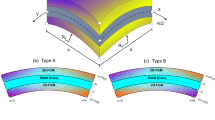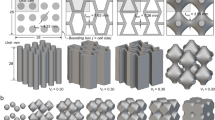Abstract
Vibratory finishing has been widely used for surface finishing, cleaning, deburring, deflashing, and stress relief in industry for the past 60 years. In vibratory finishing, the motion behaviors of granular media, determined by a vibratory excitation system, dictate the material removal from and surface quality of workpieces. In this study, a dynamic bowl-type vibratory finishing machine model was developed using ADAMS software. The behavior of the granular media in the vibrating flow field was simulated and analyzed using the EDEM software. The add-in EALink was used to transmit data between ADAMS and EDEM. For model verification, the vibration amplitudes of a container were experimentally measured using acceleration sensors. The contact force of the granular media acting on the workpieces and the velocities of the granular media and workpieces were obtained through co-simulation. Co-simulation can be used to estimate the uniformity of processed workpieces. Finishing experiments were conducted for comparison with co-simulation results using workpieces fixed to the inner wall of the container.
Similar content being viewed by others
References
Gillespie LR (2006) Mass finishing handbook. Industrial Press Inc., New York
Sangid MD, Stori JA, Ferriera PM (2011) Process characterization of vibrostrengthening and application to fatigue enhancement of aluminum aerospace components—part I. Experimental study of process parameters. Int J Adv Manuf Technol 53(5–8):545–560. https://doi.org/10.1007/s00170-010-2857-2
Sangid MD, Stori JA, Ferriera PM (2011) Process characterization of vibrostrengthening and application to fatigue enhancement of aluminum aerospace components—part II: process visualization and modeling. Int J Adv Manuf Technol 53(5–8):561–575. https://doi.org/10.1007/s00170-010-2858-1
Yang SQ, Li WH, Chen HL (2011) Surface finishing theory and new technology. National Defense Press, Beijing
Mediratta R, Ahluwalia K, Yeo SH (2016) State-of-the-art on vibratory finishing in the aviation industry: an industrial and academic perspective. Int J Adv Manuf Technol 85(1–4):415–429
Domblesky J, Cariapa V, Evans R (2003) Investigation of vibratory bowl finishing. Int J Prod Res 41(16):3943–3953
Hashimoto F, Johnson SP (2015) Modeling of vibratory finishing machines. CIRP Ann Manuf Technol 64(1):345–348. https://doi.org/10.1016/j.cirp.2015.04.004
Wang S, Timsit RS, Spelt JK (2000) Experimental investigation of vibratory finishing of aluminum. Wear 243(1):147–156. https://doi.org/10.1016/S0043-1648(00)00437-3
Yabuki A, Baghbanan MR, Spelt JK (2002) Contact forces and mechanisms in a vibratory finisher. Wear 252(7):635–643. https://doi.org/10.1016/S0043-1648(02)00016-9
Fleischhauer E, Azimi F, Tkacik P, Keanini R, Mullany B (2016) Application of media image velocimetry (PIV) to vibrational finishing. J Mater Process Technol 229:322–328
Hashemnia K, Mohajerani A, Spelt JK (2013) Development of a laser displacement probe to measure media impact velocities in vibrationally fluidized granular flows. Powder Technol 235:940–952
Hashemnia K, Spelt JK (2014) Particle impact velocities in a vibrationally fluidized granular flow: measurements and discrete element predictions. Chem Eng Sci 109:123–135. https://doi.org/10.1016/j.ces.2014.01.027
Uhlmann E, Eulitz A, Dethlefs A (2015) Discrete element modelling of drag finishing. Procedia CIRP 31:369–374
Naeini SE, Spelt JK (2009) Two-dimensional discrete element modeling of a spherical steel media in a vibrating bed. Powder Technol 195(2):83–90. https://doi.org/10.1016/j.powtec.2009.05.016
Naeini SE, Spelt JK (2011) Development of single-cell bulk circulation in granular media in a vibrating bed. Powder Technol 211(1):176–186. https://doi.org/10.1016/j.powtec.2011.04.018
Hashemnia K, Spelt JK (2015) Finite element continuum modeling of vibrationally-fluidized granular flows. Chem Eng Sci 129:91–105. https://doi.org/10.1016/j.ces.2015.02.025
Tian YB, Zhong ZW, Tan SJ (2016) Kinematic analysis and experimental investigation on vibratory finishing. Int J Adv Manuf Technol 86(9–12):3113–3121. https://doi.org/10.1007/s00170-016-8378-x
Cariapa V, Park H, Kim J, Cheng C, Evaristo A (2008) Development of a metal removal model using spherical ceramic media in a centrifugal disk mass finishing machine. Int J Adv Manuf Technol 39(1–2):92–106
Boschetto A, Bottini L, Veniali F (2013) Microremoval modeling of surface roughness in barrel finishing. Int J Adv Manuf Technol 69(9–12):2343–2354
Uhlmann E, Dethlefs A, Eulitz A (2014) Investigation into a geometry-based model for surface roughness prediction in vibratory finishing processes. Int J Adv Manuf Technol 75(5–8):815–823
Wan S, Liu YC, Woon KS (2016) A simple general process model for vibratory finishing. Int J Adv Manuf Technol 86(9–12):2393–2400. https://doi.org/10.1007/s00170-016-8379-9
Vijayaraghavan V, Castagne S (2016) Sustainable manufacturing models for mass finishing process. Int J Adv Manuf Technol 86(1–4):49–57. https://doi.org/10.1007/s00170-015-8146-3
EDEM Website, https://www.edemsimulation.com/
Cundall PA, Strack ODL (1979) A discrete numerical model for granular assemblies. Geotechnique 29(1):47–65. https://doi.org/10.1680/geot.1979.29.1.47
Zhang L, Li WH, Yang SQ (2016) Calibration of discrete element parameters of media in mass finishing process, China. Sci Pap 11:1821–1825
Xu C, Zheng N, Li L (2016) Bouncing behavior and dissipative characterization of a chain-filled granular damper. Powder Technol 297:367–373. https://doi.org/10.1016/j.powtec.2016.04.019
Douady S, Fauve S, Laroche C (1989) Subharmonic instabilities and defects in a granular layer under vertical vibrations. Europhys Lett 8(7):621
Jiang ZH (2005) Period doubling motion in vertically vibrated granular beds. Acta Phys Sin 54(12):5692–5698
Archard JF (1953) Contact and rubbing of flat surfaces. J Appl Phys 24(8):981–988. https://doi.org/10.1063/1.1721448
Acknowledgements
The authors would like to acknowledge the National Natural Science Foundation of China (Grant No. U1510118) and Shanxi Province Programs for Science and Technology Development (Grant No. 2015031011-3).
Author information
Authors and Affiliations
Corresponding author
Rights and permissions
About this article
Cite this article
Wang, X., Yang, S., Li, W. et al. Vibratory finishing co-simulation based on ADAMS-EDEM with experimental validation. Int J Adv Manuf Technol 96, 1175–1185 (2018). https://doi.org/10.1007/s00170-018-1639-0
Received:
Accepted:
Published:
Issue Date:
DOI: https://doi.org/10.1007/s00170-018-1639-0




